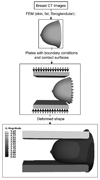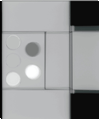Validation of a method for measuring the volumetric breast density from digital mammograms
- PMID: 20463377
- PMCID: PMC3052857
- DOI: 10.1088/0031-9155/55/11/003
Validation of a method for measuring the volumetric breast density from digital mammograms
Abstract
The purpose of this study was to evaluate the performance of an algorithm used to measure the volumetric breast density (VBD) from digital mammograms. The algorithm is based on the calibration of the detector signal versus the thickness and composition of breast-equivalent phantoms. The baseline error in the density from the algorithm was found to be 1.25 +/- 2.3% VBD units (PVBD) when tested against a set of calibration phantoms, of thicknesses 3-8 cm, with compositions equivalent to fibroglandular content (breast density) between 0% and 100% and under x-ray beams between 26 kVp and 32 kVp with a Rh/Rh anode/filter. The algorithm was also tested against images from a dedicated breast computed tomography (CT) scanner acquired on 26 volunteers. The CT images were segmented into regions representing adipose, fibroglandular and skin tissues, and then deformed using a finite-element algorithm to simulate the effects of compression in mammography. The mean volume, VBD and thickness of the compressed breast for these deformed images were respectively 558 cm(3), 23.6% and 62 mm. The displaced CT images were then used to generate simulated digital mammograms, considering the effects of the polychromatic x-ray spectrum, the primary and scattered energy transmitted through the breast, the anti-scatter grid and the detector efficiency. The simulated mammograms were analyzed with the VBD algorithm and compared with the deformed CT volumes. With the Rh/Rh anode filter, the root mean square difference between the VBD from CT and from the algorithm was 2.6 PVBD, and a linear regression between the two gave a slope of 0.992 with an intercept of -1.4 PVBD and a correlation with R(2) = 0.963. The results with the Mo/Mo and Mo/Rh anode/filter were similar.
Figures











Similar articles
-
Characterization of the homogeneous tissue mixture approximation in breast imaging dosimetry.Med Phys. 2012 Aug;39(8):5050-9. doi: 10.1118/1.4737025. Med Phys. 2012. PMID: 22894430 Free PMC article.
-
The relationship between anatomic noise and volumetric breast density for digital mammography.Med Phys. 2012 Aug;39(8):4660-8. doi: 10.1118/1.4736422. Med Phys. 2012. PMID: 22894390
-
Estimation of breast percent density in raw and processed full field digital mammography images via adaptive fuzzy c-means clustering and support vector machine segmentation.Med Phys. 2012 Aug;39(8):4903-17. doi: 10.1118/1.4736530. Med Phys. 2012. PMID: 22894417 Free PMC article.
-
Automatic Estimation of Volumetric Breast Density Using Artificial Neural Network-Based Calibration of Full-Field Digital Mammography: Feasibility on Japanese Women With and Without Breast Cancer.J Digit Imaging. 2017 Apr;30(2):215-227. doi: 10.1007/s10278-016-9922-9. J Digit Imaging. 2017. PMID: 27832519 Free PMC article.
-
Quantification of breast density with dual energy mammography: a simulation study.Med Phys. 2008 Dec;35(12):5411-8. doi: 10.1118/1.3002308. Med Phys. 2008. PMID: 19175100 Free PMC article.
Cited by
-
Fully Automated Quantitative Estimation of Volumetric Breast Density from Digital Breast Tomosynthesis Images: Preliminary Results and Comparison with Digital Mammography and MR Imaging.Radiology. 2016 Apr;279(1):65-74. doi: 10.1148/radiol.2015150277. Epub 2015 Oct 21. Radiology. 2016. PMID: 26491909 Free PMC article.
-
Automated mammographic breast density estimation using a fully convolutional network.Med Phys. 2018 Mar;45(3):1178-1190. doi: 10.1002/mp.12763. Epub 2018 Feb 19. Med Phys. 2018. PMID: 29363774 Free PMC article.
-
High mammographic density in women of Ashkenazi Jewish descent.Breast Cancer Res. 2013 May 13;15(3):R40. doi: 10.1186/bcr3424. Breast Cancer Res. 2013. PMID: 23668689 Free PMC article.
-
An analysis of the mechanical parameters used for finite element compression of a high-resolution 3D breast phantom.Med Phys. 2011 Oct;38(10):5756-70. doi: 10.1118/1.3637500. Med Phys. 2011. PMID: 21992390 Free PMC article.
-
Measurement of breast density with digital breast tomosynthesis--a systematic review.Br J Radiol. 2014 Nov;87(1043):20140460. doi: 10.1259/bjr.20140460. Epub 2014 Aug 22. Br J Radiol. 2014. PMID: 25146640 Free PMC article.
References
-
- Boone JM, Alexander LC, Kwan J, Seibert A, Shah N, Karen KL, Nelson TR. Technique factors and their relationship to radiation dose in pendant geometry breast CT. Med. Phys. 2005;32:3767–3776. - PubMed
-
- Boone JM, Cooper VN., III Scatter/primary in mammography: Monte Carlo validation. Med. Phys. 2000;27:1818–1831. - PubMed
-
- Boone JM, Fewell TR, Jennings RJ. Molybdenum, rhodium, and tungsten anode spectral models using interpolating polynomials with application to mammography. Med. Phys. 1997;24:1863–1874. - PubMed
-
- Boone JM, Kwan AL, Yang K, Burkett GW, Lindfors KK, Nelson TR. Computed tomography for imaging the breast. J. Mammary Gland Biol. Neoplasia. 2006a;11:103–111. - PubMed
-
- Boone JM, Lindfors KK, Cooper VN, III, Seibert JA. Scatter/primary in mammography: comprehensive results. Med. Phys. 2000;27:2408–2416. - PubMed
Publication types
MeSH terms
Grants and funding
LinkOut - more resources
Full Text Sources
Other Literature Sources
Medical
